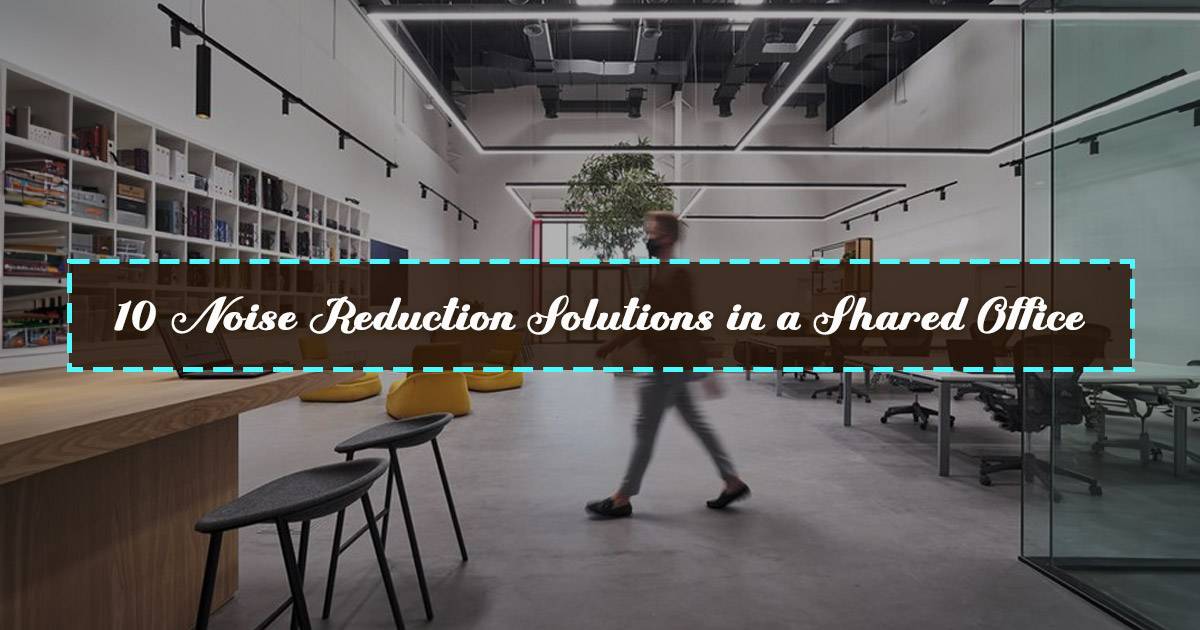10 Office Noise Reduction Solutions: Tips to Reduce Distractions & Boost Focus

Working in an office is one of the most common jobs worldwide. Before COVID-19, no more than 5% of Americans worked from home more than three days per week. Although working from home became very popular during the pandemic, with around 42% of people working remotely at its peak, many still prefer going back to the office. A survey by the Pew Research Center found that 41% of workers who can work remotely now choose to do so part-time or occasionally.
Working in an office has its perks—face-to-face collaboration, easy access to resources, and a clear divide between work and home life. However, one big problem is the constant noise and lack of personal space, especially in shared offices. If you’re looking for ways to escape the noise and chaos, there are several tips you can follow to make your workspace more peaceful.
The Setup and Common Issues in Shared Office Spaces
A shared office, often known as a coworking space, typically features an open-plan layout where multiple individuals or teams work in the same area. These spaces are designed to encourage collaboration and flexibility, with communal desks, open seating areas, conference rooms, and shared amenities like kitchens and lounges.
1. Noise
Background chatter, ringing phones, footsteps, and general activity create a constant stream of noise. This can lead to frustration, decreased productivity, and increased stress levels among workers.
2. Lack of Personal Space
With everyone sharing the same space, it’s hard to find a quiet corner or private area. Employees often feel cramped and distracted, which can negatively impact their focus and efficiency.
3. Interruption
Frequent interruptions from coworkers walking by or starting impromptu conversations can break concentration and reduce overall work output.
4. Limited Privacy
Open spaces mean limited privacy for phone calls or confidential conversations. Workers may feel uneasy discussing sensitive information and seek out less effective solutions, like stepping outside or finding a secluded spot.
Creating a Peaceful Office Environment: Noise Reduction Solutions
There are several effective ways to make your office area less chaotic and more peaceful. By using these noise reduction solutions, you can significantly cut down on distractions and create a more productive work environment.
1. Noise-Friendly Flooring
Using flooring materials like engineered hardwood or luxury vinyl tile (LVT) designed for sound absorption can reduce the echo of footsteps and other noises. To add this to your space, consider replacing hard flooring with these noise-friendly options.
2. Dedicated Quiet Spaces
Creating designated quiet zones or rooms where noise is minimized allows employees to focus without distractions. You can set up these areas by assigning specific rooms or corners of the office as quiet zones with clear signage.
3. Noise-Canceling Headphones
Providing high-quality noise-canceling headphones for employees can help block out ambient sounds. Simply purchase and distribute these headphones to your team members, encouraging them to use them when they need to concentrate.
4. Sound-Masking Devices
Using white noise machines or ambient sound devices can mask disruptive noises by creating a consistent background sound. Place these devices in common areas or near workstations to help drown out conversations and other distracting noises.
5. Acoustic Panels and Partitions
Installing acoustic wall panels, ceiling panels, or movable partitions can absorb sound and reduce reverberation. Add these to your space by placing panels on walls and ceilings or using partitions to separate noisy areas from quieter ones.
6. Carpet Flooring
Covering floors with carpets can help absorb sound and reduce noise from footsteps and furniture movement. Consider adding rugs or carpeting to high-traffic areas to muffle sounds and create a quieter atmosphere.
7. Fabric Office Furniture
Choosing soft, fabric-covered furniture over hard surfaces helps absorb noise rather than reflect it. Replace some of your hard-surfaced furniture with fabric-covered options to reduce overall noise levels.
8. Strategically Placed Plants
Using large, leafy plants to absorb sound and improve air quality can act as natural sound barriers. Place plants around the office, especially near noisy areas, to reduce noise while enhancing the look and feel of the workspace.
9. Acoustic Pods
Installing acoustic pods or soundproof booths for private phone calls and focused work provides quiet spaces within the open office layout. Add these pods to your office by purchasing prefabricated models and setting them up in strategic locations.
10. Advocating Asynchronous Communication
Encouraging asynchronous communication among remote teams minimizes real-time noise. Promote this approach by suggesting that team members use email or messaging apps instead of holding frequent, noisy meetings.
Benefits of a Quieter Shared Office
Creating a quieter shared office can make a big difference in how well people work. When there’s less noise, employees can focus better, which means they get more done and work more efficiently. A calmer workspace also reduces stress and helps everyone feel more relaxed and satisfied with their jobs.
A quiet office makes it easier for people to communicate clearly without getting confused, which is important for teamwork and completing projects successfully. By adding noise reduction solutions, you not only improve the quality of work but also create a more pleasant and professional environment for everyone.
In the end, a peaceful office isn’t just about cutting down on noise; it’s about creating a space where everyone can do their best work and feel comfortable. So, take steps to make your office quieter and enjoy the benefits of a more focused, happy, and productive team.
